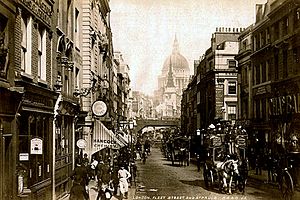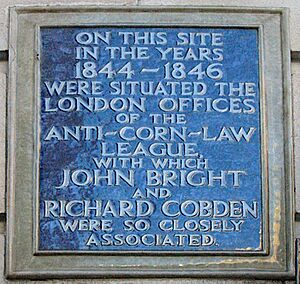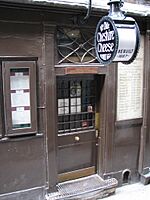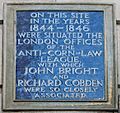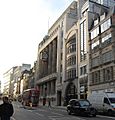Fleet Street facts for kids

Fleet Street in 2008
|
|
| Part of | A4 |
|---|---|
| Namesake | River Fleet |
| Maintained by | Transport for London |
| Length | 0.3 mi (0.5 km) |
| Postal code | EC4 |
| Nearest train station | |
| Coordinates | 51°30′50″N 0°06′38″W / 51.5138°N 0.1105°W |
Fleet Street is a famous street in Central London, England. It runs from Temple Bar in the west to Ludgate Circus in the east. Temple Bar marks the border between the City of London and Westminster. Ludgate Circus is where the old London Wall used to be. The street gets its name from the River Fleet, which once flowed nearby.
This street has been an important route since Roman times. During the Middle Ages, many businesses and important church leaders were based here. Some old churches, like Temple Church and St Bride's, are still there today. Fleet Street became famous for printing and publishing in the 1500s. By the 1900s, most British national newspapers had their offices here.
In the 1980s, much of the newspaper industry moved out. This happened after News International built cheaper printing places in Wapping. However, some old newspaper buildings are now protected and have been saved. The name Fleet Street is still used to mean the British national press. Many pubs on the street, once popular with journalists, are still busy today.
Fleet Street also has many monuments and statues. These include the dragon statue at Temple Bar. There are also memorials to important figures from the British press. These include Samuel Pepys and Lord Northcliffe. The street is mentioned in several books by Charles Dickens. It is also known as the home of the fictional murderer Sweeney Todd.
Contents
Where is Fleet Street Located?
Fleet Street is named after the River Fleet. This river flows from Hampstead down to the River Thames. It is on the western edge of the City of London. Fleet Street is one of the oldest roads outside the original city walls. It was first used in the Middle Ages. In the 1200s, it was called Fleet Bridge Street. By the early 1300s, it became known simply as Fleet Street.
The street starts at Temple Bar, which is the boundary between the City of London and Westminster. It continues east from the Strand, which comes from Trafalgar Square. Fleet Street crosses Chancery Lane and Fetter Lane. It then reaches Ludgate Circus near the old London Wall. The road continues as Ludgate Hill.
The numbers on buildings run from west to east on the south side. Then they run from east to west on the north side. This street connects the old Roman and medieval parts of the city. Part of Fleet Street is now part of the A4. This is a main road that goes west through London.
You can reach Fleet Street by public transport. The nearest London Underground stations are Temple, Chancery Lane, and Blackfriars. City Thameslink railway station is also nearby. Many London Bus routes, like 4, 11, 15, and 23, travel along Fleet Street.
Fleet Street's Long History
Early Days of Fleet Street
Fleet Street was an important road in Roman London. There is proof that a road existed here by 200 AD. Digs have found parts of a Roman amphitheatre near Ludgate. However, some say the area was too wet for many Romans to live there. The Saxons did not live in the Roman city. Instead, they built their settlement, Lundenwic, further west.
Many important church leaders lived near the street in the Middle Ages. These included bishops and abbots. Making leather from animal hides became common on Fleet Street. This was because of the nearby river. But this caused a lot of pollution. So, by the mid-1300s, dumping rubbish was banned. Many pubs, called taverns, were also built along Fleet Street. Records show them as early as the 1300s.
A key feature in the late Middle Ages was a water conduit. This was the main water supply for the area. When Anne Boleyn became queen in 1533, the conduit flowed with wine instead of water! By the 1500s, Fleet Street was very crowded. In 1580, a royal rule tried to stop new buildings. But this did not work well, and building continued. Prince Henry's Room, built in 1610, is named after Henry Frederick, Prince of Wales.
The eastern part of the street was destroyed by the Great Fire of London in 1666. This happened even though people tried to use the River Fleet to stop the fire. The fire reached about Fetter Lane. Special courts were held to decide property rights after the fire. Buildings were rebuilt in the same style as before.
In the early 1700s, a group called the Mohocks caused trouble on the street. They were known for violence and vandalism.
Leather making and other industries greatly decreased after the River Fleet was put underground in 1766. The street was made wider in the late 1800s. This is when Temple Bar was taken down and Ludgate Circus was built. The main office of the Anti-Corn Law League was at No. 67 Fleet Street. A blue plaque marks this spot today.
Fleet Street: Home of Newspapers

Printing began on Fleet Street around 1500. William Caxton's apprentice, Wynkyn de Worde, opened a print shop near Shoe Lane. At the same time, Richard Pynson also started a publishing and printing business. More printers followed. They mainly printed for the legal businesses in the area. They also published books and plays.
In March 1702, London's first daily newspaper, the Daily Courant, was published on Fleet Street. The Morning Chronicle followed it. The publisher John Murray started at No. 32 Fleet Street in 1762. They stayed there until 1812. Newspapers were not very popular at first due to taxes. These included a tax on paper. Peele's Coffee-House at No. 177–178 Fleet Street became a popular meeting place. It was the main room for the Society for Repealing the Paper Duty, starting in 1858. This group succeeded, and the tax was removed in 1861.
With the end of the newspaper tax in 1855, newspaper printing on Fleet Street grew a lot. "Penny press" newspapers, costing just one penny, became popular in the 1880s. Many different newspapers eventually combined into a few big national ones.
By the 1900s, Fleet Street was the center of national newspapers. The Daily Express moved to No. 121–8 Fleet Street in 1931. Its building was designed by Sir Owen Williams. It was the first curtain wall building in London. It is still there today. The Daily Telegraph was based at No. 135–142. Both these buildings are now protected. In the 1930s, No. 67 housed 25 different publications. By this time, most British homes bought a daily paper made on Fleet Street.
In the late 1900s, new printing technology changed things. Newspaper companies and journalists started leaving Fleet Street. In 1986, News International owner Rupert Murdoch moved The Times and The Sun to new places in Wapping. Murdoch believed it was too expensive to print newspapers on Fleet Street. He also felt the power of the print unions was too strong.
All Fleet Street print staff were let go. New staff were hired to use modern computer-controlled machines in Wapping. This made the old unions less powerful. The Wapping dispute involved protests at Fleet Street and Wapping. It lasted over a year. But other publishers soon followed and moved out of Fleet Street. Reuters was the last major news company to leave in 2005.
Some publishers have stayed on Fleet Street. The London office of D.C. Thomson & Co., which creates The Beano, is at No. 185. The British Association of Journalists is at No. 89.
Even though many newspapers have moved, the name Fleet Street still means the printing and publishing world. The St Bride Library is nearby. It has a special collection about printing and offers courses. A mural on Magpie Alley shows the history of newspapers in the area.
The Daily Express was the last newspaper printed on Fleet Street. This happened on November 17, 1989. The last two journalists for Sunday Post left in 2016.
Fleet Street Today
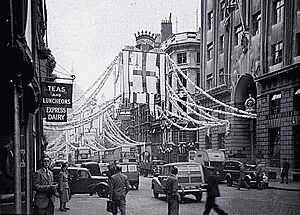
Even with the newspaper industry, other businesses were on Fleet Street. The Automobile Association started at No. 18 Fleet Street in 1905. Since the newspapers moved, Fleet Street is now more about banking, law, and accounting. The Inns of Court, where lawyers work, are in alleys off Fleet Street. Many old newspaper offices are now headquarters for different companies. For example, Goldman Sachs has offices in the old Daily Telegraph building.
C. Hoare & Co, England's oldest private bank, has been on Fleet Street since 1672. Child & Co., another bank, claims to be the oldest continuous bank in the UK. It started in 1580 and has been at No. 1 Fleet Street since 1673. The law firm Freshfields moved to No. 65 Fleet Street in 1990.
Since 1971, the south side of the street has been a protected area. This helps keep the buildings well-maintained and saves the street's special character. The protected area expanded to the north side in 1981.
Important Buildings on Fleet Street
In the High Middle Ages, important church leaders had their London homes on this street. Names like Peterborough Court and Salisbury Court remind us of their houses. The Whitefriars monastery is remembered by Whitefriars Street. Parts of its old underground rooms are still there for people to see. A Carmelite church was built on Fleet Street in 1253. But it was destroyed during the Reformation in 1545.
Today, three churches serve the people in the area. Temple Church was built by the Knights Templar in 1162. It serves the legal profession. St Bride's Church was built as early as the 500s. It was later designed by Sir Christopher Wren. It is still the church most linked to the printing industry. St Dunstan-in-the-West also dates from the 1100s. It is the local church and home to the Romanian Orthodox church in London.
To the south are many legal buildings known as the Temple. This area used to belong to the Knights Templar. It includes two of the four Inns of Court: the Inner Temple and the Middle Temple. Many lawyers' offices are nearby. The gatehouse to Middle Temple Lane was built by Sir Christopher Wren in 1684. To the west, at the junction with Strand, are the Royal Courts of Justice. At the eastern end of the street, the Old Bailey is near Ludgate Circus.
Fleet Street was a main road into and out of the City. It was well-known for its pubs and coffeehouses. Many famous writers and politicians, like Samuel Johnson, visited these places. Journalists often met in pubs to gather news. Some of these pubs are still open today and are protected buildings. These include Ye Olde Cock Tavern at No. 22, The Tipperary at No. 66, the Old Bell at No. 95, the Punch Tavern at No. 98, and Ye Olde Cheshire Cheese at No. 145. The El Vino wine bar moved to No. 47 in 1923. It quickly became popular with lawyers and journalists. Women were not allowed in the bar until 1982. The Old Bank of England building is now a protected pub.
Statues and Memorials
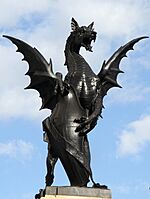
Fleet Street has many statues and memorials. At the north-eastern corner, there is a bust of Edgar Wallace. There is also a full statue of Mary, Queen of Scots at No. 143–144. Above the entrance to the old school-house of St Dunstan's is a statue of Queen Elizabeth I. It was moved here in 1776. Next to this is a bust of Lord Northcliffe, a newspaper owner. At No. 72, there is a bust of the Irish journalist T. P. O'Connor, built in 1934.
On the south side of the street, you'll find the Temple Bar Memorial. This is where the old Temple Bar gateway used to stand. The memorial was designed by Sir Horace Jones in 1880. It has a statue of a dragon on top, sometimes called "the Griffin." It also has a statue of Queen Victoria.
In the Inner Temple Gardens, there is a memorial to Charles Lamb. In Salisbury Square, there is a tall stone monument for Robert Waithman. He was the mayor of London from 1823 to 1833. A blue plaque also marks the birthplace of Samuel Pepys, a famous diarist.
Famous People Connected to Fleet Street
Many writers and politicians are linked to Fleet Street. They either lived there or regularly visited its pubs. These include Ben Jonson, John Milton, Izaak Walton, John Dryden, Edmund Burke, Oliver Goldsmith, and Charles Lamb. The dictionary writer Samuel Johnson lived at Gough Square, just off Fleet Street, from 1748 to 1759. His building is still standing today. The mapmaker John Senex owned a map store on Fleet Street from 1725 until his death in 1736. Wynkyn de Worde was buried in St. Bride's Church in 1535. The poet Richard Lovelace was also buried there in 1657. Samuel Pepys was baptized there in 1633.
The Royal Society was based in Crane Court from 1710 to 1782. It then moved to Somerset House on the Strand.
Images for kids
-
A blue plaque marking the location of the Anti-Corn Law League headquarters on No. 67 Fleet Street
-
The former headquarters of The Daily Telegraph at No. 135–141
-
Fleet Street pictured in 1953, with flags hung for the coronation of Queen Elizabeth II
-
The Temple Bar Memorial, one of the boundary markers of the City of London
See also
 In Spanish: Fleet Street para niños
In Spanish: Fleet Street para niños
- The Printworks, Fleet Street of the North
- Holborn, with a description of the surrounding area
- Bahadur Shah Zafar Marg in Delhi, known as the Fleet Street of India
- Paternoster Row




